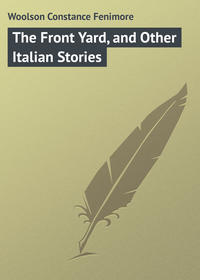 полная версия
полная версияMentone, Cairo, and Corfu
I dare say that there was more laughter still (under the veils) when the cause of all this haste appeared, coming slowly up the stairs. It was a small man of sixty-five or seventy, one of my own countrymen, attired in a linen duster and a travel-worn high hat; his silver-haired head was bent over his guide-book, and he wore blue spectacles. I don't think he saw anything but blue antiquities, safely made of stone.
Hareem carriages (that is, ladies' carriages) in Cairo are large, heavily built broughams. The occupants wear thin white muslin or white tulle veils tied across the face under the eyes, with an upper band of the same material across the forehead; but these veils do not in reality hide the features much more closely than do the dotted black or white lace veils worn by Europeans. The muffling outer draperies, however, completely conceal the figure, and this makes the marked difference between them and their English, French, and American sisters in the other carriages near at hand. On the box of the brougham, with the coachman, the eunuch takes his place. To go out without a eunuch would be a humiliation for a Cairo wife; to her view, it would seem to say that she is not sufficiently attractive to require a guardian. The hareem carriage of a man of importance has not only its eunuch, but also its sais, or running footman; often two of them. These winged creatures precede the carriage; no matter how rapid the pace of the horses, they are always in advance, carrying, lightly poised in one hand, high in the air, a long lance-like wand. Their gait is the most beautiful motion I have ever seen. The Mercury of John of Bologna; the younger gods of Olympus – will these do for comparisons? One calls the sais winged not only because of his speed, but also on account of his large white sleeves (in English, angel sleeves), which, though lightly caught together behind, float out on each side as he runs, like actual wings. His costume is rich – a short velvet jacket thickly embroidered with gold; a red cap with long silken tassel; full white trousers which end at the knee, leaving the legs and feet bare; and a brilliant scarf encircling the small waist. These men are Nubians, and are admirably formed; often they are very handsome. Naturally one never sees an old one, and it is said that they die young. Their original office was to clear a passage for the carriage through the narrow, crowded streets; now that the streets are broader, they are not so frequently seen, though Egyptians of rank still employ them, not only for their hareem carriages, but for their own. They are occasionally seen, also, before the victoria or the landau of European residents; but in this case their Oriental dress accords ill with the stiff, tight Parisian costumes behind them. Now and then one sees them perched on the back seat of an English dog-cart, and here they look well; they always sit sidewise, with one hand on the back of the seat, as though ready at a moment's notice to spring out and begin flying again.
If the figures of the Cairo ladies are always well muffled, one has at least abundant opportunity to admire the grace and strength of the women of the working classes. When young they have a noble bearing. Their usual dress is a long gown of very dark blue cotton, a black head veil, and a thick black face veil that is kept in its place below the eyes by a gilded ornament which looks like an empty spool. Often their beautifully shaped slender feet are bare; but even the poorest are decked with anklets, bracelets, and necklaces of beads, imitation silver or brass. The men of the working classes wear blue gowns also, but the blue is of a much lighter hue; many of them, especially the farmers and farm laborers (called fellaheen), have wonderfully straight flat backs and broad, strong shoulders. Europeans, when walking, appear at a great disadvantage beside these loosely robed people; all their movements seem cramped when compared with the free, effortless step of the Arab beside them.
THE BAZAARSOne spends half one's time in the bazaars, perhaps. One admires them and adores them; but one feels that their attraction cannot be made clear to others by words. Nor can it be by the camera. There are a thousand photographic views of Cairo offered for sale, but, with the exception of an attempt at the gateway of the Khan Khaleel, not one copy of these labyrinths, which is a significant fact. Their charm comes from color, and this can be represented by the painter's brush alone. But even the painter can render it only in bits. From a selfish point of view we might perhaps be glad that there is one spot left on this earth whose characteristic aspect cannot be reproduced, either upon the wall or the pictured page, whose shimmering vistas must remain a purely personal memory. We can say to those who have in their minds the same fantastic vision, "Ah, you know!" But we cannot make others know. For what is the use of declaring that a collection of winding lanes, some of them not more than three feet broad, opening into and leading out of each other, unpaved, dirty, roofed far above, where the high stone houses end, with a lattice-work of old mats – what is the use of declaring that this maze is one of the most delightful places in the world? There is no use; one must see it to believe it.
We approach the bazaars by the Mooski, a street which has lost all its ancient attraction – which is, in fact, one of the most commonplace avenues I know. But near its end the enchantment begins, and whether we enter the flag bazaar, the lemon-colored-slipper bazaar, the gold-and-silver bazaar, the bazaar of the Soudan, the bazaar of silks and embroideries, the bazaar of Turkish carpets, or the lane of perfumes felicitously named by the donkey-boys the smell bazaar, we are soon in the condition of children before a magician's table. I defy any one to resist it. The most tired American business man looks about him with awakened interest, the lines of his face relax and turn into the wrinkles we associate with laughter, as he sees the small, frontless shops, the long-skirted merchants, and the sewing, embroidering, cross-legged crowd. The best way, indeed, to view the bazaars is to relax – to relax your ideas of time as well as of pace, and not be in a hurry about anything. Accompany some one who is buying, but do not buy yourself; then you can have a seat on the divan, and even (as a friend of the purchaser) one of those wee cups of black coffee which the merchant offers, and which, whether you like it or not, you take, because it belongs to the scene. Thus seated, you can look about at your ease.
In these days, when every one is rereading the Arabian Nights, the learned in Burton's translation, the outside public in Lady Burton's, even the most unmethodical of writers feels himself, in connection with Cairo, forced towards the inevitable allusion to Haroun. But once within the precincts of the Khan Khaleel, he does not need to have his fancy jogged by Burton or any one else; he thinks of the Arabian Nights instinctively, and "it's a poor tale," indeed, to quote Mrs. Poyser, if he does not meet the one-eyed calendar in the very first booth. But, as has already been said, it is useless to describe. All one can do is to set down a few impressions. One of the first of these is the charming light. The sunshine of Egypt has a great radiance, but it has also – and this is especially visible when one looks across any breadth of landscape – a pleasant quality of softness; it is a radiance which is slightly hazy and slightly golden brown, being in these respects quite unlike the pellucid white light of Greece. The Greeks frown; even the youngest of the handsome men who go about in ballet-like white petticoats and the brimless cap, has the ugly little perpendicular line between the eyes, produced by a constant knitting of the brows. Like the Greek, the Egyptian also is without protection for his eyes; the dragoman wears a small shawl over the fez, which covers the back of the neck and sides of the face, the Bedouins have a hood, but the large majority of the natives are unprotected. It is said that a Mohammedan can have no brim to his turban or tarboosh, because he must place his bare forehead upon the ground when he says his prayers, and this without removing his head-gear (which would be irreverent). However this may be, he goes about in Egypt with the sun in his eyes, though, owing to the softer quality of the light, he does not frown as the Greek frowns. For those who are not Egyptians, however, the light in Cairo sometimes seems too omnipresent; then, for refuge, they can go to the bazaars. The sunshine is here cut off horizontally by thick walls, and from above it is filtered through mats, whose many interstices cause a checker of light and shade in an infinite variety of unexpected patterns on the ground. This ground is watered. Somehow the air is cool; coming in from the bright streets outside is like entering an arbor. The little shops resemble cupboards; their floors are about three feet above the street. They have no doors at the back. When the merchant wishes to close his establishment, he comes out, pulls down the lid, locks it, and goes home. A picturesque characteristic is that in many cases the wares are simply sold here; they are also made, one by one, upon the spot. You can see the brass-workers incising the arabesques of their trays; you can see the armorers making arms, the ribbon-makers making ribbons, the jewellers blowing their forges, the ivory-carvers bending over their delicate task. As soon as each article is finished, it is dusted and placed upon the little shelf above, and then the apprentice sets to work upon a new one. In addition to the light, another thing one notices is the amazing way in which the feet are used. In Cairo one soon becomes as familiar with feet as one is elsewhere with hands; it is not merely that they are bare; it is that the toes appear to be prehensile, like fingers. In the bazaars the embroiderers hold their cloth with their toes; the slipper-makers, the flag-cutters, the brass-workers, the goldsmiths, employ their second set of fingers almost as much as they employ the first. Both the hands and feet of these men are well formed, slender, and delicate, and, by the rules of their religion, they are bathed five times each day.
Mosques are near where they can get water for this duty. For the bazaars are not continuous rows of shops: one comes not infrequently upon the ornamental portal of an old Arabian dwelling-house, upon the forgotten tomb of a sheykh, with its low dome; one passes under stone arches; often one sees the doorway of a mosque. Humble-minded dogs, who look like jackals, prowl about. The populace trudges through the narrow lanes, munching sugar-cane whenever it can get it. Another favorite food is the lettuce-plant; but the leaves, which we use for salad, the Egyptians throw away; it is the stalk that attracts them.
Lettuce-stalks are not rich food, but the bazaars of the people who eat them convey, on the whole, an impression of richness; this is owing to the sumptuousness of the prayer carpets, the gold embroideries, the gleaming silks, the Oriental brass-work with sentences from the Koran, the ivory, the ostrich plumes, the little silver bottles for kohl, the inlaid daggers, the turquoises and pearls, and the beautiful gauzes, a few of them embroidered with the motto, "I do this work for you," and on the reverse side, "And this I do for God." To some persons, the far-penetrating mystic sweetness from the perfume bazaar adds an element also. Here sit the Persian merchants in their delicate silken robes; they weigh incense on tiny scales; they sort the gold-embossed vials of attar of roses; their taper fingers move about amid whimsically small cabinets and chests of drawers filled with ambrosial mysteries. There is magic in names; these merchants are doubly interesting because they come from Ispahan! Scanderoun – there is another; how it rolls off the tongue! We do not wish for exact geographical descriptions of these places; that would spoil all. We wish to chant, like Kit Marlowe's Tamburlaine (and with similar indefiniteness):
"Is it not passing brave to be a king,And march in triumph through Persepolis?""So will I ride through Samarcanda streets,… to Babylon, my lords; to Babylon!"When we leave Cairo we cannot take with us the light of these labyrinths; we cannot take their colors; but one traveller, last May, having found in an antiquity-shop an ancient perfume-burner, had the inspiration of bargaining with these Persians, seated cross-legged in their aromatic niches (said traveller on a white donkey outside), for small packages of sandal and aloes wood, of myrrh, of frankincense and ambergris, of benzoin, of dried rose leaves, and of other Oriental twigs and sticks, for the purpose of summing up, later, and in less congenial climes perhaps, the spicy atmosphere, at least, of the Cairo bazaars. What would be the effect of breathing always this fragrant air? Would it give a richer life, would it tinge the cheek with warmer hues? These merchants have complexions like cream-tinted tea-roses; their dark eyes are clear, and all their movements graceful; they are very tranquil, but not in the least sleepy; they look as if they could take part in subtle arguments, and pursue the finest chains of reasoning. Would an atmosphere perfumed by these Eastern woods clarify and rarefy our denser Occidental minds?
THE NILEAs every one who comes to Cairo goes up the Nile, the river is seldom thought of as it appears during its course past the Khedive's city. This simple vision of it is overshadowed by memories of Abydos, of Karnak and Thebes, and Philæ – the great temples on its banks which have impressed one so profoundly. Perhaps they have over-impressed; possibly the tension of continuous gazing has been kept up too long. In this case the victim, with his head in his hands, is ready to echo the (extremely true) exclamation of Dudley Warner, "There is nothing on earth so tiresome as a row of stone gods standing to receive the offerings of a Turveydrop of a king!" This was the mental condition of a lady who last winter, on a Nile boat, suddenly began to sew. "I have spent nine long days on this boat, staring from morning till night. One cannot stare at a river forever, even if it is the Nile! Give me my thimble."
One is not obliged to leave Cairo in order to see examples of the smaller silhouettes of the great river – the shadoofs or irrigating machines, the rows of palm-trees, the lateen yards clustered near a port, and always and forever the women coming down the bank to get water from the yellow tide. These processions of women are the most characteristic "Nile scene with figures" of the present day. I am not sure but that one of their jars, or the smaller gray kulleh (which by evaporation keeps the water deliciously cool), would evoke "Egypt" more quickly in the minds of most of us than even the portrait of Cleopatra herself on the back wall at Denderah. If one is staying in Cairo after the tremendous voyage is over, one wanders to the banks every now and then to gaze anew at the broad, monotonous stream. It comes from the last remaining unknown territory of our star, and this very year has seen that space grow smaller. Round about it stand to-day five or six of the civilized nations, who have formed a battue, and are driving in the game. The old river had a secret, one of the three secrets of the world; but though the North and South Poles still remain unmapped, the annual rise of its waters will be strange no longer when Lado is a second Birmingham. How will it seem when we can telephone to Sennaar (perhaps to that ambassador beloved by readers of the Easy Chair), or when there is early closing in Darfur?
At Cairo, when one rides or drives, one almost always crosses the Nile; but Cairo herself does not cross. Her more closely built quarters do not even come down to the shore. The Nile and Cairo are two distinct personalities; they are not one and indivisible, as the Nile and Thebes are one, the Nile and Philæ.
The river at Cairo has a dull appearance. Its only beauty comes from the towering snow-white sails of the dahabeeyahs and trading craft that crowd the stream. It is true that these have a great charm.
DOMESTIC ARCHITECTUREIn the old quarters this is Arabian. The beauty lies largely in the latticed balconies called mouchrabiyehs, which overhang the narrow roadways. These bay-windows sometimes stud the façades thickly, now large, now small, but always a fretwork of delicate wood-carving. Often from the bay projects a second and smaller oriel, also latticed. This is the place for the water jar, the current of air through the lattices keeping the water cool. An Arabian house has no windows on the ground-floor in its outer wall save small air-holes placed very high, but above are these mouchrabiyehs, which are made of bits of cedar elaborately carved in geometrical designs. The small size of the pieces is due to the climate, the heats of the long summer would warp larger surfaces of wood; but the delicacy and intricacy of the carving are a work of supererogation due to Arabian taste. From the mouchrabiyehs the inmates can see the passers-by, but the passers-by cannot see the inmates, an essential condition for the carefully guarded privacy of the family.
There is in Cairo a personage unconnected with the government who, among the native population, is almost as important as the Khedive himself; this is the Sheykh Ahmed Mohammed es Sadat, the only descendant in the direct line of the Prophet Mohammed now living. He has the right to many native titles, though he does not put them on his quiet little visiting-card, which bears only his name and a mysterious monogram in Arabic. By Europeans he is called simply the Sheykh (the word means chief) es Sadat. The ancestral dwelling of the sheykh shares in its master's distinction. It is pointed out, and, when permission can be obtained, visited. It is a typical specimen of Saracenic domestic architecture, and has always remained in the possession of the family, for whom it was first erected eight hundred years ago. There are in Cairo other Arabian houses as beautiful and as ancient as this. By diplomatic (and mercenary) arts I gained admittance to three, one of which has walls studded with jasper and mother-of-pearl. But these exquisite chambers, being half ruined, fill the mind with wicked temptations. One longs to lay hands upon the tiles, to bargain for an inscription or for a small oriel with the furtive occupants, who have no right to sell, the real owners being Arabs of ancient race, who would refuse to strip their walls, however crumbling, for unbelievers from contemptible, paltry lands beyond the sea. The house of the Sheykh es Sadat may not leave one tranquil, for it is tantalizingly picturesque, but at least it does not inspire larceny; the presence of many servitors prevents that. To reach this residence one leaves (gladly) the Boulevard Mohammed Ali, and takes a narrower thoroughfare, the Street of the Sycamores, which bends towards the south. This lane winds as it goes, following the course of the old canal, the Khaleeg, and one passes many of the public fountains, or sebeels, which are almost as numerous in Cairo as the mosques. A fountain in Arab signification does not mean a jet of water, but simply a place where water can be obtained. The sebeels are beautiful structures, often having marble walls, a dome, and the richest kind of ornament. The water is either dipped with a cup from the basin within, or drawn from the brass mouth-pieces placed outside. Nothing could represent better, I think, the difference between the East and the West than one of these elaborate fountains, covering, in a crowded quarter, the space which might have been occupied by two or three small houses, adorned with carved stone-work, slabs of porphyry, and long inscriptions in gilt, and an iron town pump, its erect slenderness taking up no space at all, and its excellent if unbeautiful handle standing straight out against the sky.
A narrow lane, leaving the Street of the Sycamores, burrows still more deeply into the heart of the quarter, and at last brings us to a porch which juts into the roadway, masking, as is usual in Cairo, the real doorway, which is within. Upon entering, one finds himself in a quadrilateral court, which is open to the sky. An old sycamore shades several latticed windows, among them one which contains three of the smaller oriels; this portion of the second story rests upon an antique marble column. On one side of the column is the low, rough archway leading to the porch; on the other, the high decorated marble entrance of the reception-hall. For in Arabian houses all the magnificence is kept for the interior. In the streets one sees only plain stone walls, which are often hidden under a stucco of mud, more or less peeled off, so that they look half ruined. In the old quarters of Cairo, among the private houses, one obtains, indeed (unless one has an invitation to enter), a general impression of ruin. At the back of the sheykh's court is the stairway to the hareem, the entrance masked by a gayly colored curtain. Across another side extends the private mosque, only half hidden by an ornamented grating. One can see the interior and the high pulpit decked with the green flag of the Prophet. The walls which encircle the court, and which are embellished here and there with Arabic inscriptions, are of differing heights, as they form parts of separate structures which have been erected at various periods through the eight centuries. The place is, in fact, an agglomeration of houses, and some of the older chambers are crumbling and roofless. The central court (which shows its age only in a picturesque trace or two) is adorned with at least twenty beautiful mouchrabiyehs, some large, some small, and no two on the same level. A charm of Saracenic architecture is that you can always make discoveries, nothing is stereotyped; of a dozen delicate rosettes standing side by side under a balcony, no two are carved in the same design.
In a room which stretches back to the garden – and which at the time of our visit was empty, save for a row of antique silver-gilt coffee-pots standing on the marble floor – there is a long, low window, like a band in the wall, formed of small carved lattices. The hand of Abbey only, I think, could reproduce the beauty of this casement; but instead of the charming seventeenth-century English girls whom he would wish to place there, realism would demand the hideous eunuchs, with their gold chains and scarf-pins; or else (and this would be better) the dignified old Arab in a white turban who sat cross-legged in the court with his long pipe, his half-closed eyes expressing his disdain for the American visitors. The courtesy of the master of the house, however, made up for his servitor's scorn. The sheykh is a tall man, somewhat too portly, with amiable dark eyes, and a gleam of humor in his face. One scans his features with interest, as if to catch some reflection of the Prophet; but the rays from an ancestor who walked the earth twelve hundred years ago are presumably faint. There is nothing modern in the sheykh's attire; his handsome flowing gown is of silk; he wears a turban, slippers, and an India shawl wound round his waist like a sash. When the air is cool, he shrouds him self in a large outer cloak of fine dark blue cloth, which is lined with white fur. Sometimes Signor Ahmed carries in his hand the Mohammedan rosary. This string of beads appears to be used as Madame de Staël used her "little stick," as the English called it (in Italy, more poetically, they named it "a twig of laurel"). Corrinne must always have this beside her plate at dinner to play with before she conversed, or rather declaimed. Her maid, in confidence, explained that it was necessary to madame "to stimulate her ideas." One often sees the rosary on duty when two Turks are conversing. After a while, their subjects failing them, they fall into silence. Then each draws out his string from a pocket, and they play with their beads for a moment or two, until, inspiration reviving, they begin talking again. One hopes that poor Ahmed Mohammed has not been driven to his string too often as mental support during dumb visits from Anglo-Saxon tourists, who can do nothing but stare at him. The sheykh's reception-hall is forty feet wide and sixty feet long. The ceiling, which has the Saracenic pendentives in the corners and under the beams, is of wood, gilded and painted and carved in the characteristic style which one vainly tries to describe. Travellers have likened it to an India shawl; to me it seemed to approach more nearly the wrong side of a Persian scarf, which shows the many-hued silken ravellings. The effect, as a whole, though extraordinarily rich, is yet subdued. The walls are encrusted with old blue tiles which mount to the top. At one end of the room there is a beautiful wall-fountain. And now comes the other side of the story. To enjoy all this beauty, you must not look down; for, alas! the marble floor is tightly covered with a modern French carpet; chairs and tables of the most ordinary modern designs have taken the place of the old divans; and these tables, furthermore, are ornamented with hideous bouquets of artificial flowers under glass. Finally, the tiles which have fallen from the lower part of the walls have not been replaced by others; a coarse fresco has been substituted. What would not one give to see the sheykh, who is himself a purely Oriental figure, seated in this splendid hall of his fathers as it once was, on one of the now superseded divans, the marbles of his floor uncovered save for his discarded Turkish rugs, the fountain sending forth its rose-water spray, perfume burning in the silver receivers, and no encumbering furniture save piles of brocaded cushions and a jar or two on the gilded shelf.









